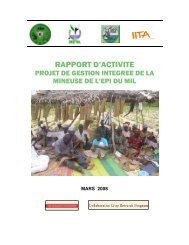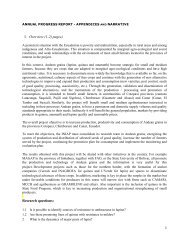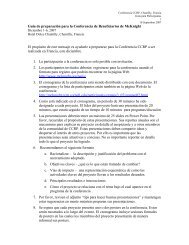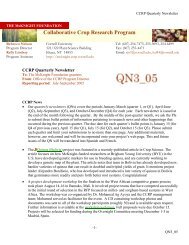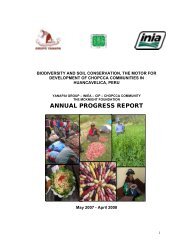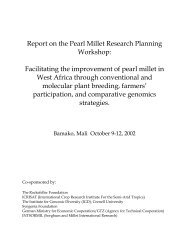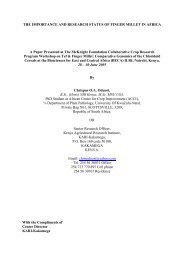English - McKnight Foundation Collaborative Crop Research Program
English - McKnight Foundation Collaborative Crop Research Program
English - McKnight Foundation Collaborative Crop Research Program
Create successful ePaper yourself
Turn your PDF publications into a flip-book with our unique Google optimized e-Paper software.
<strong>McKnight</strong> <strong>Foundation</strong> <strong>Collaborative</strong> <strong>Crop</strong>s <strong>Research</strong> Project No: 06-741<br />
Approach<br />
A participatory research approach of working with organized village farmer groups was adopted. These<br />
included participatory research models such as demonstrations, displays and training through hands-on<br />
experience. Appreciative problem solving methods were used to encourage farmers learn, explore and<br />
practice new skills and knowledge.<br />
Sample size<br />
The number of farmers in each group varied between 15-35 members. Level of women representation<br />
was 58 percent of the total number. The study participants were mainly smallholder farmers drawn from<br />
eight villages in three regions. These farmers provided the information on producers and consumers.<br />
These farmers mostly grew cowpeas for subsistence and they were the one who tackled the issue of<br />
consumer preference. Other participants included government officials, district and village extension<br />
officers.<br />
Training of farmers and local processors<br />
A one day workshop was conducted in each project area and farmers were trained on improved cowpea<br />
technologies. The trainings were based on demonstrations, hands-on trials and printed materials<br />
(bronchures for cowpea recipes). Farmers participated in the validation of five recipes for cowpea value<br />
addition. Sensory tests were carried out, where by farmers were required to rank and find out the most<br />
preferred type of”bagia”. The five types of bagia were made using different recipes (see Table 1). The<br />
recipes were translated into national language for better understanding.<br />
Table 18: Cowpea snack product recipes<br />
Bagia type Materials/ingredients<br />
1. Bagia asilia Cowpea dhal/flour, salt, cooking oil, water<br />
2. Bagia asilia na viungo Cowpea flour, salt, cooking oil, garlic, onions and water<br />
3. Bagia; viungo na hamira Cowpea flour, salt, cooking oil, onions, garlic, yeast and<br />
water<br />
4. Bagia; viungo na mayai Cowpea flour, salt, cooking oil, garlic, onions, eggs and<br />
water<br />
5. bagia; viungo, mayai na hamira Cowpea flour, salt, cooking oil, onions, garlic, eggs,<br />
yeast and water<br />
Common method used<br />
• Mix all the ingredients together<br />
• Add water and mix well<br />
• Make the dough by needing (allow the dough to rise by leaving it for 10-15 minutes)<br />
• Heat cooking oil until really hot.<br />
• Use spoon or hand to make the size of bagia you need and put the dough into the oil<br />
• Stir and cook until brown<br />
• Remove from oil and drain<br />
• Cool and pack for marketing or save for consumption.<br />
Farmers were equipped with skills and knowledge on quality control with emphasis on the storage<br />
techniques. Also they were informed about product grading/sorting, market requirements of quality,<br />
quantity and sustainability. The training also emphasized on the methods of de-hulling whole cowpea<br />
grain for dhal production that can be converted into other value added and snack products, such as<br />
“bagia”. The value added products are considered nutritious and sources of income generation. It was<br />
however, observed that the prevailing low production levels, lack of adequate and appropriate storage<br />
facilities constrained the sustainability of the niche markets.<br />
17<br />
2009



